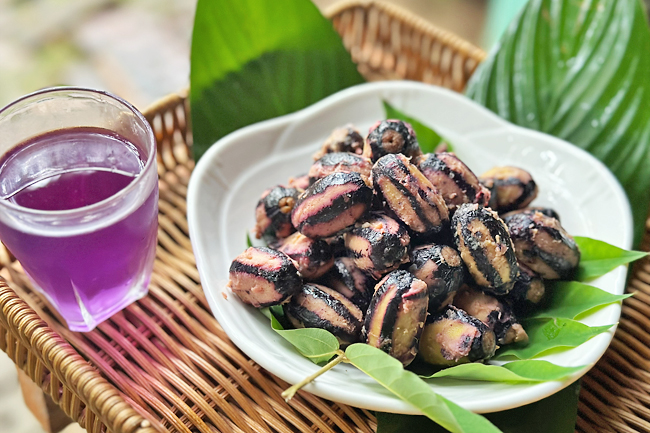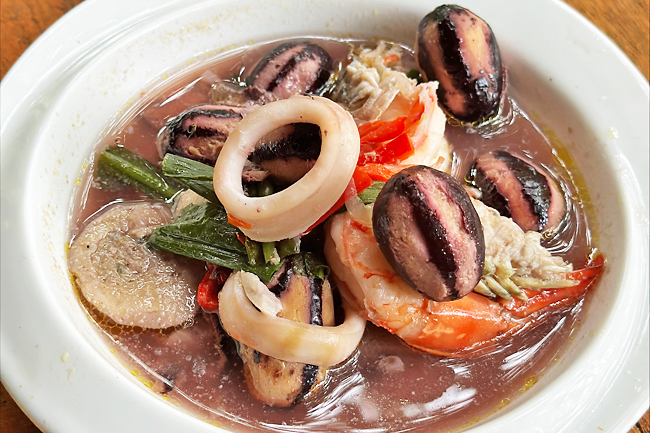The humble kembayau, also known as the Bornean olive, is a seasonal star in the Sultanate. During its peak, markets come alive with mounds of the small and glossy black fruit, heralding the onset of a cherished nightly tradition known only to kembayau enthusiasts.
It is a fruit available during certain times of the year, and depending on the climate, the best times to harvest it are between July and August, and November and December.
Under the moon’s glow, Bruneians, armed with knives or spoons, would scrape off the skin, revealing the pale yellow flesh underneath.
The process would amusingly leave their fingers tinged with a rich shade of purple, rather than the anticipated black.
Part of the kembayau’s unique flavour profile comes from the skin, making the practice of partially peeling them a widespread tradition, leading to a striped pattern.
The conventional method of preparing kembayau is straightforward: soak the peeled fruits in warm water, strain, and add sugar or salt. Many liken its taste to the richness of avocado, but did you know that the kembayau knows no bounds?
Across the border in Sarawak, Malaysia, it’s known as dabai and locals have integrated it into dishes like fried rice, sambal and soups.
On the Bruneian front, Fatimah binti Jalil, a chef at a farm-to-table initiative in the Tutong District, preserves traditional recipes and also revamps them. The 46-year-old, who runs and operates her own ‘food jungle’- a jungle garden dedicated to growing edible plants – finds value in diversifying the use of native ingredients and is always seeking fresh ways to savour the traditional.
During a recent culinary showcase at Eco Ponies Garden in Tutong, where the spotlight was on kembayau, Fatimah showcased the beloved fruit, using them in a savoury seafood soup and a spicy yet hearty sambal – promising a novel culinary adventure with this age-old jungle ingredient.



“I used to follow the traditional methods like most Bruneians, soaking them in hot water or pickling them,” Fatimah recalled.
“It wasn’t until I saw a family cook them with sardines that I realised their culinary potential. That experience sparked the idea that kembayau could be prepared in diverse ways,” she said.
The culinary showcase served as an educational platform dedicated to promoting the Borneo native fruit.
Notably, the humble fruit has also been proven to offer significant health benefits, including antioxidant properties, cholesterol reduction, prevention of type 2 diabetes, and lowering the risk of heart disease.
It’s amusing how everyday this fruit is for the average Bruneian and Bornean, yet for those beyond our region, it offers a uniquely rich experience that is truly incomparable. The distinctiveness persists, even though our food cultures in the region share certain similarities.
For travellers Mitch Dutton and Haley Perkins from the United States, the sentiment rings true as they admitted to never having the Borneo olive, prior to visiting Brunei Darussalam.
“Before it’s cooked its super bitter, and not very edible.
“I know because I accidentally tried a raw one at the market. But once they’re cooked, they have this amazingly creamy taste. I wasn’t expecting that at all,” shared Dutton.
Both individuals had also encountered sambal before, but never one that incorporated kembayau into the paste.
Dutton particularly appreciated the bold fusion of the fruit’s intense flavour with the seafood notes. He also expressed his gratitude for the opportunity to be part of the kembayau preparation process, savouring the unique culinary experience first-hand.
“Peeling the kembayau was fun. The jokes, conversion, and connection around the table while completing this task was what makes cooking so special. Even with language barriers it’s a moment where we all understand each other,” added Perkins.
The sambal kembayau recipe begins by soaking kembayau in hot water, while dried shrimp, calamansi, red and bird’s eye chillies, and a pinch of salt are pounded together.
After pounding, the mixture is stir-fried with a bit of oil until fragrant. Once the kembayau is added to the aromatic blend, the flavourful dish pairs perfectly with rice or serves as a delightful appetiser.
Meanwhile for the kembayau soup with seafood recipe, clean your choice of seafood thoroughly and set it aside for later use. The aromatics including ginger, shallots, garlic and chillies should be finely chopped while the lemongrass is bruised.
Prepare the aromatics by finely chopping the ginger, thinly slicing the shallots, mincing the garlic, and slicing the red chillies. To enhance the flavours, bruise the lemongrass stalks to release their aroma. Additionally, tear the ketumbar jawa (cilantro) and Kaffir lime leaves.
Heat cooking oil in a pan over medium heat and sauté chopped ginger, shallots, and minced garlic until fragrant and golden brown. Add sliced red chillies and bruised lemongrass, stir-frying until chilies soften.
Introduce the seafood mix, cooking until opaque and gently mix in the soaked and peeled kembayau.
Pour one to one-and-a-half cups of water and bring to a gentle boil. Season with salt and seasoning powder to taste, ensuring even distribution. Add the torn cilantro and Kaffir lime leaves, letting flavours meld. – Wardi Wasil


